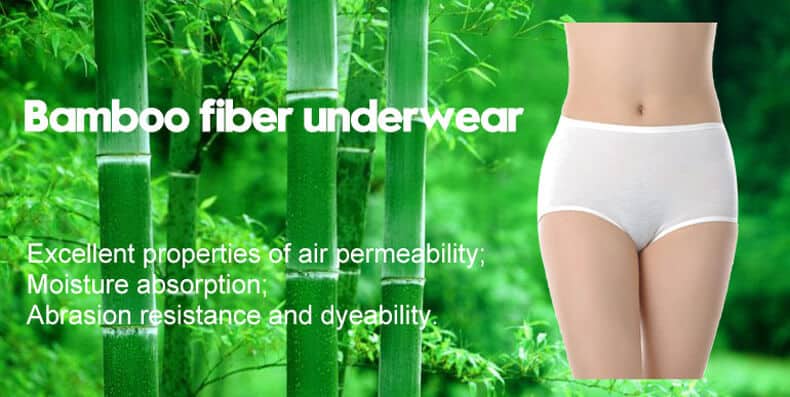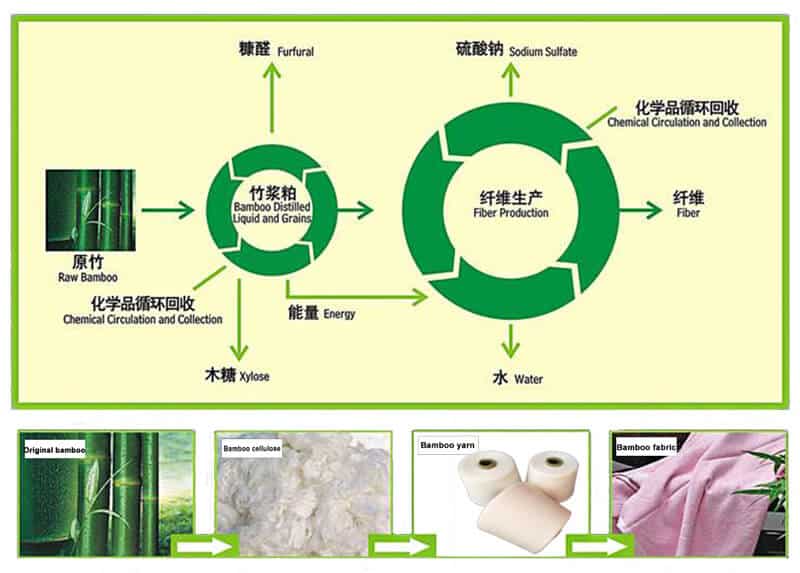What is bamboo fiber? The bamboo fiber is a sort of cellulose fiber extracted from naturally grown bamboo. It has excellent properties of air permeability, moisture absorption, abrasion resistance and dyeability. The underwear made of bamboo is absorbent and breathable, anti-bacterial and anti-UV, and also has the functions of deodorization and mites inhibition.
What bamboo fiber is?
Bamboo fiber is a kind of regenerated cellulose fiber produced by patent technology, which uses bamboo as the raw material, extracts cellulose, hemicellulose and lignin from it, and then manufactures pulp and spinning.
Observed under the electron microscopy, the bamboo fiber has transverse nodes in the longitudinal direction, and its thickness distribution is rather uneven. And there are numerous fine grooves on the surface of the fiber. The transverse section is an irregular oval covered with big and small pores, whose edges are cracked.
It is a kind of functional fabric that similar with hand feeling of cotton fabric. Its price is only slightly higher than pure cotton, but most of the characteristics are better than purified cotton. Therefore, more and more bamboo clothing manufacturers began to use bamboo fiber as a raw material to produce underwear and other underclothes.

Benefits of bamboo fiber properties
Compared with the fiber made of cotton or wood, the bamboo fiber made of bamboo has good air permeability, better dyeing and drape, and it can make the woven clothes feel soft, wear-resistant, shiny and bright, with good spinability, and has real antibacterial and deodorant properties.
Although bamboo has a slightly lower content of alpha cellulose than wood, it is rich in resources and grows rapidly. Bamboo is a kind of fast-growing and high-yield fibrous raw material which grows widely and can be cut down in 4-5 years after planting. The utilization of bamboo to produce fiber pulp alleviates the contradiction between supply and demand of plant fiber raw materials and is beneficial to the comprehensive protection of forest resources.
1, Anti-bacterial and bactericidal
Bamboo fiber products have natural effects on resisting, inhibiting and killing bacteria, because of a substance named “bamboo quinones” that has natural functions of bacteria and mites inhibition, deodorization and insects repellent.
Japanese authorities have found that bacteria can reproduce in large quantities in cotton, wooden and other fiber products under a microscope, while bacteria on bamboo fiber products can not only survive for a long time, but also disappear or decrease in a short period of time. The bacterial mortality rate within 24 hours is more than 75%.
Bamboo contains bamboo quinone with strong antibacterial properties, it has no moth, no decay, no need to use any pesticides in the process of growth. During the process of bamboo fiber production, factories use high-tech processing so that the antibacterial material always combined in cellulose macromolecules, and the antibacterial material is always not destroyed. Therefore, even after repeated washing, bamboo fiber fabric will not lose the antibacterial effect under the sun.
The natural antibacterial property makes bamboo fiber will not cause any allergy or adverse reaction to the skin in the application of clothing making, which is very different from other fibers that need to add antibacterial agent in the later dyeing or packaging process to produce a temporary antibacterial effect.
2, Anti-UV
The transmittance of ultraviolet light (UV) depends on many factors, such as micro-structure, coverage coefficient, color, chemical additives in process and sample treatment. The ultraviolet penetration rate of bamboo fiber and cotton has been tested by Shanghai Institute of Physics, Chinese Academy of Sciences. It was proved that for 200~400nm ultraviolet radiation, the penetration rate of cotton was 25%, while the penetration rate of bamboo fiber was less than 0.6%, and its UV resistance was 41.7 times higher than that of cotton. This wavelength of ultraviolet radiation is the most harmful to the human body. In terms of preventing it, bamboo fiber outperforms any other textiles.
3, Moisture absorption and air permeability
Under 2000 times electron microscope, the cross section of bamboo fiber has a bumpy and deformed surface covered with pores similar to oval, which is hollow and has a strong wicking effect, which can absorb and evaporate moisture in an instant.
The far infrared emissivity of bamboo fiber is as high as 0.87, which is much better than that of traditional fiber fabric, so it accords with the characteristics of thermal comfort. When the temperature is 36 °C and the relative humidity is 100%, the moisture regain of bamboo fiber is more than 45%, and the air permeability of bamboo fiber is 3.5 times stronger than that of cotton. Thus, it is praised as “breathing fiber” and “fiber queen” .
4, Deodorization and adsorption
The special microporous structure of bamboo fiber endows it a strong adsorption capacity, and therefore, it can adsorb formaldehyde, benzene, toluene, ammonia and other harmful substances in the air, and eliminate odour.
The results of the deodorization test of bamboo fiber are as follows:
| Initial concentration of ammonia 40PPM | |||
| Time | 0 minutes | In 2 hours | In 24 hours |
| Ammonia concentration (PPM) | 40.0 | 4.4 | 0.6 |
The experiment shows that bamboo fiber contains sodium copper chlorophyll, which has a good deodorization function.
5, Eco-friendly property
Bamboo grows for a short period of time, can be put into use within 4-5 years, even 2-3 years, and is reproduced in a long term. Bamboo can grow 3 feet overnight. It can grow and revive rapidly. It can replace cotton, wood and other resources. It can be used in a sustainable way. Bamboo fiber products can be biodegraded in the soil. Its decomposition will make no pollution to the environment. It is a pure natural, green, and environment-friendly textile raw materials.
6, Biodegradable
Natural bamboo fibers are stable at normal temperatures. But under certain conditions, it can be broken down into carbon dioxide and water. The decomposition methods are:
1) Waste disposal: Cellulose burns to produce carbon dioxide and water, no pollution to the environment.
2) It degrades when buried in soil: Microbial nutrients in the soil activate the soil, enhance soil strength, and degrade after 8-10 months.
3) Degradation in activated sludge: Mainly cellulose decomposition through the presence of a large number of bacteria.
Why can bamboo fiber inhibit and resist bacteria?
Once upon a time, people found there were few birds in the bamboo forest! Experts were curious about it and did a research , which found that there’s a substance called “bamboo quinones” in bamboo. Many bacteria are afraid of “bamboo quinones”, for if they meet this kind of substance, they will die. As a result, when there are fewer bacteria, there are fewer insects; when there are fewer insects, there is less food for birds, so they seldom come to the bamboo forest!
Cotton towels, which are commonly used in daily life, stink easily in summer because cotton products themselves cannot inhibit or resist bacteria, where mass bacteria reproduce, and cause them to be moldy, stale and sticky. The reason why bamboo fiber towel won’t be like this is mainly because it can resisting and inhibit bacteria. Bacteria can not reproduce, or even can not survive on it. So towels made of bamboo fiber are not moldy, tasteless and sticky even in warm and humid environments. It is the “bamboo quinones” that endows the bamboo fiber excellent properties of resisting,inhibiting and killing bacteria!
How to make the bamboo fiber for underwear manufacturing?
At present, for seamless clothing manufacturers, most of the commonly used bamboo fiber in the market is bamboo pulp fiber. The methods of production are as follows:
First, turn bamboo slices into fluid, then make the fluid into pulp through the process of wet spinning.
The wet spinning process is:
1, Preparation of spinning solution (that is, bamboo pulp);
2, The pulp is pressed out of the spinneret hole to form a fine flow;
3, The pulp fine stream solidifies into the primary fiber;
4, The primary fiber is coiled or post-treated directly.

In the development of bamboo pulp fiber, the bamboo pulp fiber with a content of about 35% of cellulose can be raised to over 93% by artificial catalysis, so as to meet the requirements of fiber production. In the raw material extraction and production manufacturing process, all the implementation of green production process, so bamboo fiber is environmentally friendly type of green fiber.
Disadvantage of bamboo fiber: Not resistant to acid and alkali
In cellulose macromolecules, the glucosinolates, which connect the basic links, are unstable when exposed to acid. With the structural characteristics of natural bamboo fiber, the stability of inorganic acid is smaller than that of viscose fiber.
In the same condition, the permeability of alkali to bamboo fiber is greater than that of common viscose fiber. Therefore, although the crystallinity of bamboo fiber is higher than that of ordinary viscose fiber, its alkaline resistance is poor due to the characteristics of porous glands.
Applications and uses of bamboo fiber fabric
After know what bamboo fiber fabric is, let us talk about the applications.
1) Bamboo cotton blend yarn with less than 30% bamboo fiber content is more suitable for seamless underwear, socks and other close clothes, and can also be used to make medical care products.
2) Blend with cotton, wool, hemp, silk and chemical fiber for weaving or knitting, can produce various specifications of woven fabrics and knitted fabrics. Woven fabric can be used to make curtains, jackets, casual clothes, suits, shirts, sheets and towels, bath towels, etc. Knitted fabric is suitable for underwear, sweatshirts, T-shirts, socks and so on.
3) Bamboo fiber yarn can be used in garment fabrics, cool mats, sheets, curtains, scarves, etc. Besides, blends with vinylon can produce light and thin clothing fabrics.
4) Bamboo fiber is also used in the manufacture of healthy and environmentally friendly tissue.
How about the features of underwear made of bamboo fiber?
The knitted fabrics and seamless underwear made from natural bamboo pulp fibers are different from cotton and wood cellulose fibers.
1) Good wear resistance, high moisture absorption, quick drying, high air permeability and drape.
2) Greasy plump hand-feeling, soft like silk, mildew-proof moth-proofing antibacterial, wearing cool and comfortable, have the effect of beauty and skin care.
3) Its dyeing performance is good, luster bright, and has a better natural antibacterial effect and environmental protection, comply with the modern pursuit of health and comfort trend.
Especially for the blended yarns made with bamboo fiber and other kinds of fiber for a specific proportion, it not only can reflect the performance of other fibers but also give full play to the characteristics of bamboo fiber, knitting fabric to bring new characteristics. Pure and blended yarn (blended with Tencel, Modal, Sweated Dacron, Anoxic Dacron, Corn Fiber, Cotton, Acrylic Fiber and other fibers in different types and different ratios) is the preferred fabric for knit close-fitting textiles and undergarments.
Tag service of bamboo fiber
In order to protect their rights and ensure the steady development of their products in the market, the bamboo fibre manufacturers inspect the readymade garments produced by the manufacturers who use their products. After passing the inspection, they will provide tag service according to the amount of usage.


